Corporate Accounting: Impairment Loss Calculation and Distribution
VerifiedAdded on 2023/06/12
|8
|1594
|123
Report
AI Summary
This report provides a comprehensive analysis of impairment loss for cash-generating units within the context of corporate accounting and reporting, referencing AASB 136 standards. It discusses the principles of impairment, emphasizing that assets cannot be carried above their recoverable amount, defined as the higher of fair value less selling costs and value-in-use. The report details the process of identifying impairment indications, conducting annual impairment tests for assets like goodwill, and calculating recoverable amounts. It explains how impairment losses are distributed within cash-generating units, initially reducing goodwill and then other assets on a pro-rata basis, ensuring that carrying values are not reduced below certain thresholds like value-in-use or fair value less disposal costs. A practical example involving a damaged machine illustrates the application of these principles, highlighting scenarios where impairment loss is recognized versus when reassessment of depreciation is more appropriate. The report includes a numerical example demonstrating the calculation and allocation of impairment loss across different assets, including plant, trademark, vehicle, and goodwill, along with the corresponding journal entries. It concludes by emphasizing the importance of proper accounting for impairment losses in accordance with accounting standards.
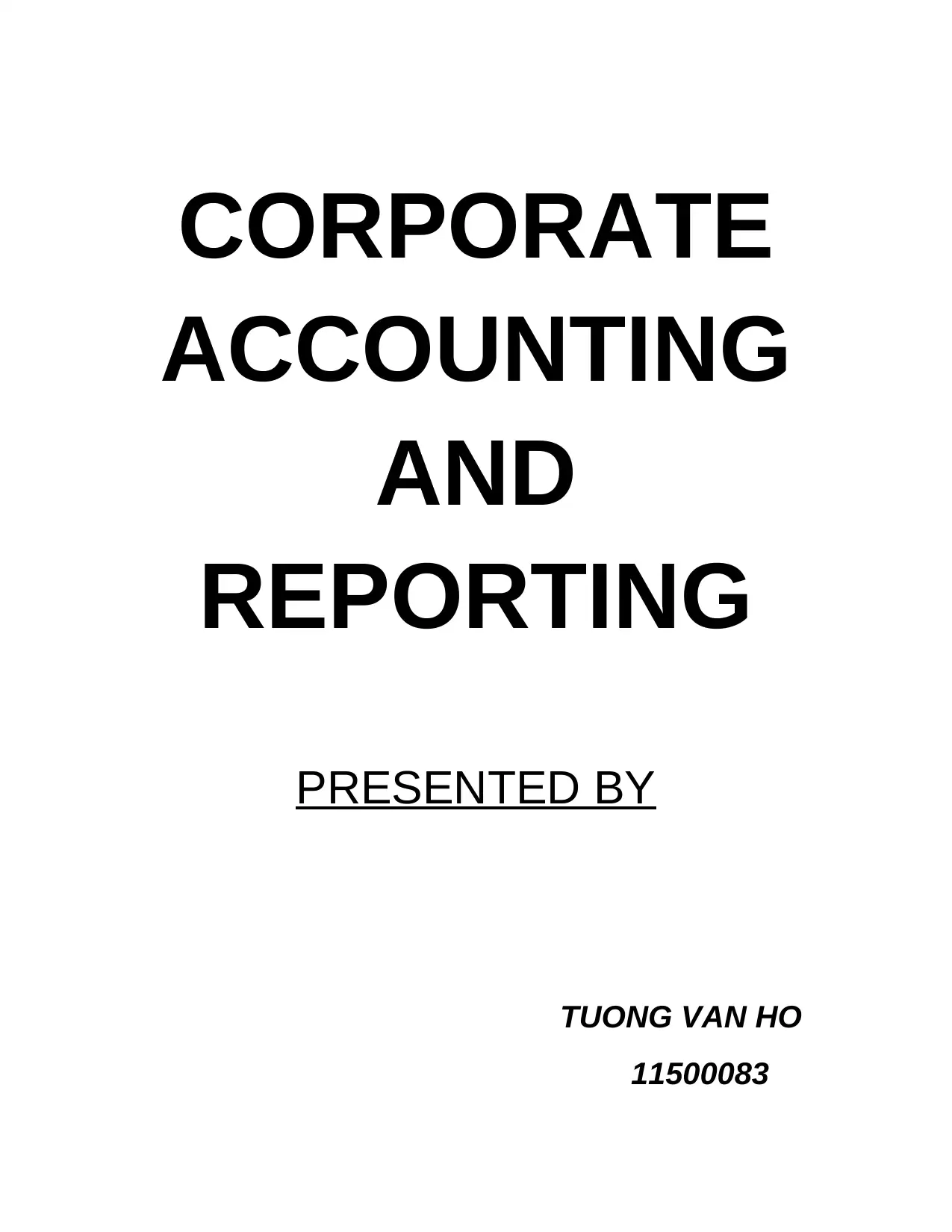
CORPORATE
ACCOUNTING
AND
REPORTING
PRESENTED BY
TUONG VAN HO
11500083
ACCOUNTING
AND
REPORTING
PRESENTED BY
TUONG VAN HO
11500083
Paraphrase This Document
Need a fresh take? Get an instant paraphrase of this document with our AI Paraphraser
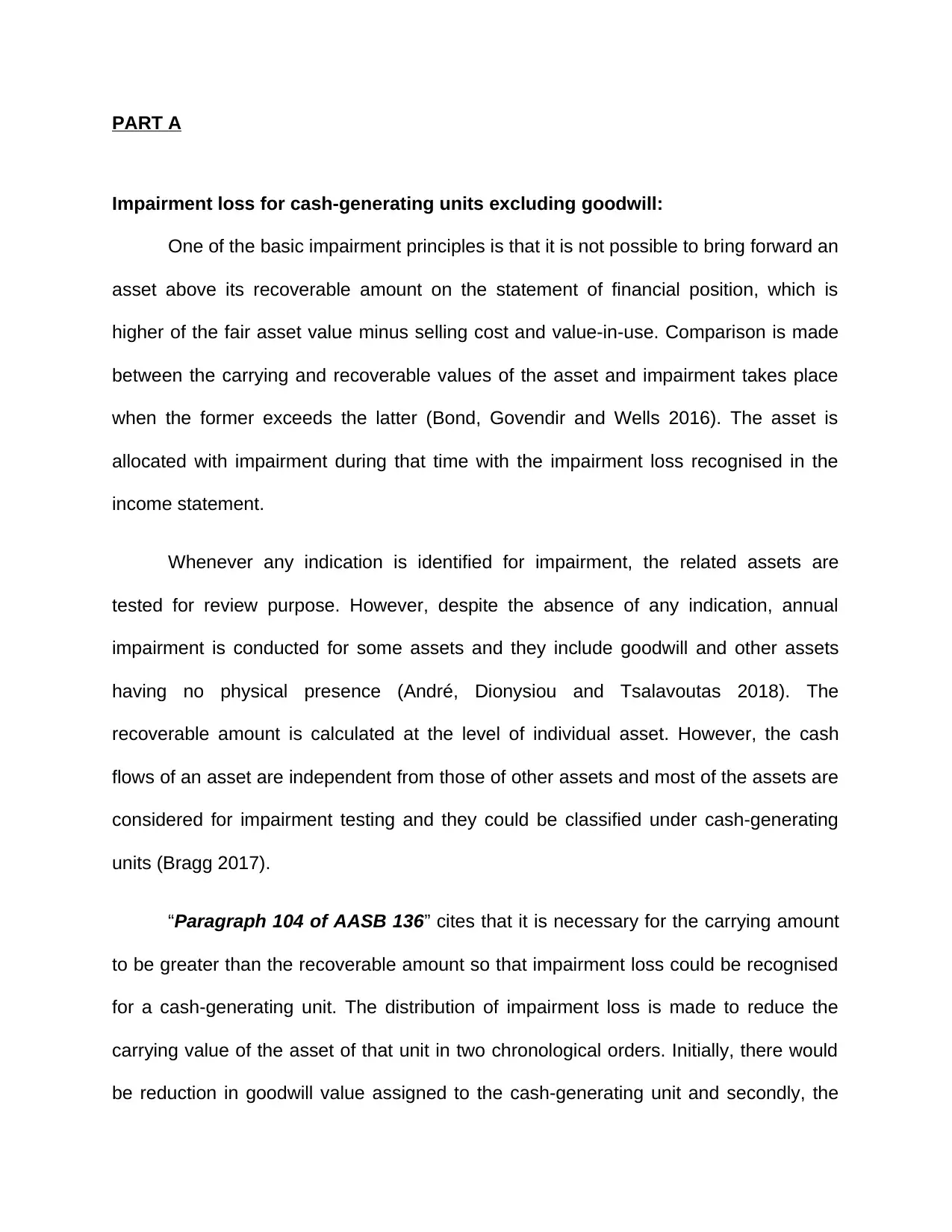
PART A
Impairment loss for cash-generating units excluding goodwill:
One of the basic impairment principles is that it is not possible to bring forward an
asset above its recoverable amount on the statement of financial position, which is
higher of the fair asset value minus selling cost and value-in-use. Comparison is made
between the carrying and recoverable values of the asset and impairment takes place
when the former exceeds the latter (Bond, Govendir and Wells 2016). The asset is
allocated with impairment during that time with the impairment loss recognised in the
income statement.
Whenever any indication is identified for impairment, the related assets are
tested for review purpose. However, despite the absence of any indication, annual
impairment is conducted for some assets and they include goodwill and other assets
having no physical presence (André, Dionysiou and Tsalavoutas 2018). The
recoverable amount is calculated at the level of individual asset. However, the cash
flows of an asset are independent from those of other assets and most of the assets are
considered for impairment testing and they could be classified under cash-generating
units (Bragg 2017).
“Paragraph 104 of AASB 136” cites that it is necessary for the carrying amount
to be greater than the recoverable amount so that impairment loss could be recognised
for a cash-generating unit. The distribution of impairment loss is made to reduce the
carrying value of the asset of that unit in two chronological orders. Initially, there would
be reduction in goodwill value assigned to the cash-generating unit and secondly, the
Impairment loss for cash-generating units excluding goodwill:
One of the basic impairment principles is that it is not possible to bring forward an
asset above its recoverable amount on the statement of financial position, which is
higher of the fair asset value minus selling cost and value-in-use. Comparison is made
between the carrying and recoverable values of the asset and impairment takes place
when the former exceeds the latter (Bond, Govendir and Wells 2016). The asset is
allocated with impairment during that time with the impairment loss recognised in the
income statement.
Whenever any indication is identified for impairment, the related assets are
tested for review purpose. However, despite the absence of any indication, annual
impairment is conducted for some assets and they include goodwill and other assets
having no physical presence (André, Dionysiou and Tsalavoutas 2018). The
recoverable amount is calculated at the level of individual asset. However, the cash
flows of an asset are independent from those of other assets and most of the assets are
considered for impairment testing and they could be classified under cash-generating
units (Bragg 2017).
“Paragraph 104 of AASB 136” cites that it is necessary for the carrying amount
to be greater than the recoverable amount so that impairment loss could be recognised
for a cash-generating unit. The distribution of impairment loss is made to reduce the
carrying value of the asset of that unit in two chronological orders. Initially, there would
be reduction in goodwill value assigned to the cash-generating unit and secondly, the

other units of the asset in terms of pro-rata depending on the carrying amount of the
assets in the unit would be minimised.
Due to minimisation of carrying amounts, the treatment would be made in the
form of impairment loss on separate assets and recognition is to be made as per
“Paragraph 60 of AASB 136” (Aasb.gov.au 2018). Moreover, “Paragraph 105 of
AASB 136” denotes that the reduction of the carrying value must not be lower than the
highest of the three available alternatives in order to distribute impairment loss. The
alternatives are mainly value-in-use, fair value less disposal cost and zero.
The amount incurred for impairment loss that could have been distributed
distinctly to the asset requires distribution on pro-rata basis to the other units of the
asset. With reference to “Paragraph 106 of AASB 136”, the recoverable amount could
not be estimated every time for the individual asset of a cash-generating unit. Therefore,
this standard requires random distribution of impairment loss between the assets of the
unit, the only exception is goodwill. This is because there is collaboration among all
classes of assets in cash-generating unit; the only exception is goodwill (Hellman 2016).
In compliance with “Paragraph 107 of AASB 136”, if it is not possible to
ascertain the recoverable amount of a separate asset, there might be occurrence of two
distinct situations. Initially, the asset realises impairment loss, if the carrying value is
greater than the fair value less disposal cost and the results of the distribution
procedures mentioned under “Paragraphs 104 and 105 of AASB 136” (Lobo et al.
2017). Lastly, the asset recognises impairment loss, if no impairment is carried out on
assets in the unit would be minimised.
Due to minimisation of carrying amounts, the treatment would be made in the
form of impairment loss on separate assets and recognition is to be made as per
“Paragraph 60 of AASB 136” (Aasb.gov.au 2018). Moreover, “Paragraph 105 of
AASB 136” denotes that the reduction of the carrying value must not be lower than the
highest of the three available alternatives in order to distribute impairment loss. The
alternatives are mainly value-in-use, fair value less disposal cost and zero.
The amount incurred for impairment loss that could have been distributed
distinctly to the asset requires distribution on pro-rata basis to the other units of the
asset. With reference to “Paragraph 106 of AASB 136”, the recoverable amount could
not be estimated every time for the individual asset of a cash-generating unit. Therefore,
this standard requires random distribution of impairment loss between the assets of the
unit, the only exception is goodwill. This is because there is collaboration among all
classes of assets in cash-generating unit; the only exception is goodwill (Hellman 2016).
In compliance with “Paragraph 107 of AASB 136”, if it is not possible to
ascertain the recoverable amount of a separate asset, there might be occurrence of two
distinct situations. Initially, the asset realises impairment loss, if the carrying value is
greater than the fair value less disposal cost and the results of the distribution
procedures mentioned under “Paragraphs 104 and 105 of AASB 136” (Lobo et al.
2017). Lastly, the asset recognises impairment loss, if no impairment is carried out on
⊘ This is a preview!⊘
Do you want full access?
Subscribe today to unlock all pages.

Trusted by 1+ million students worldwide
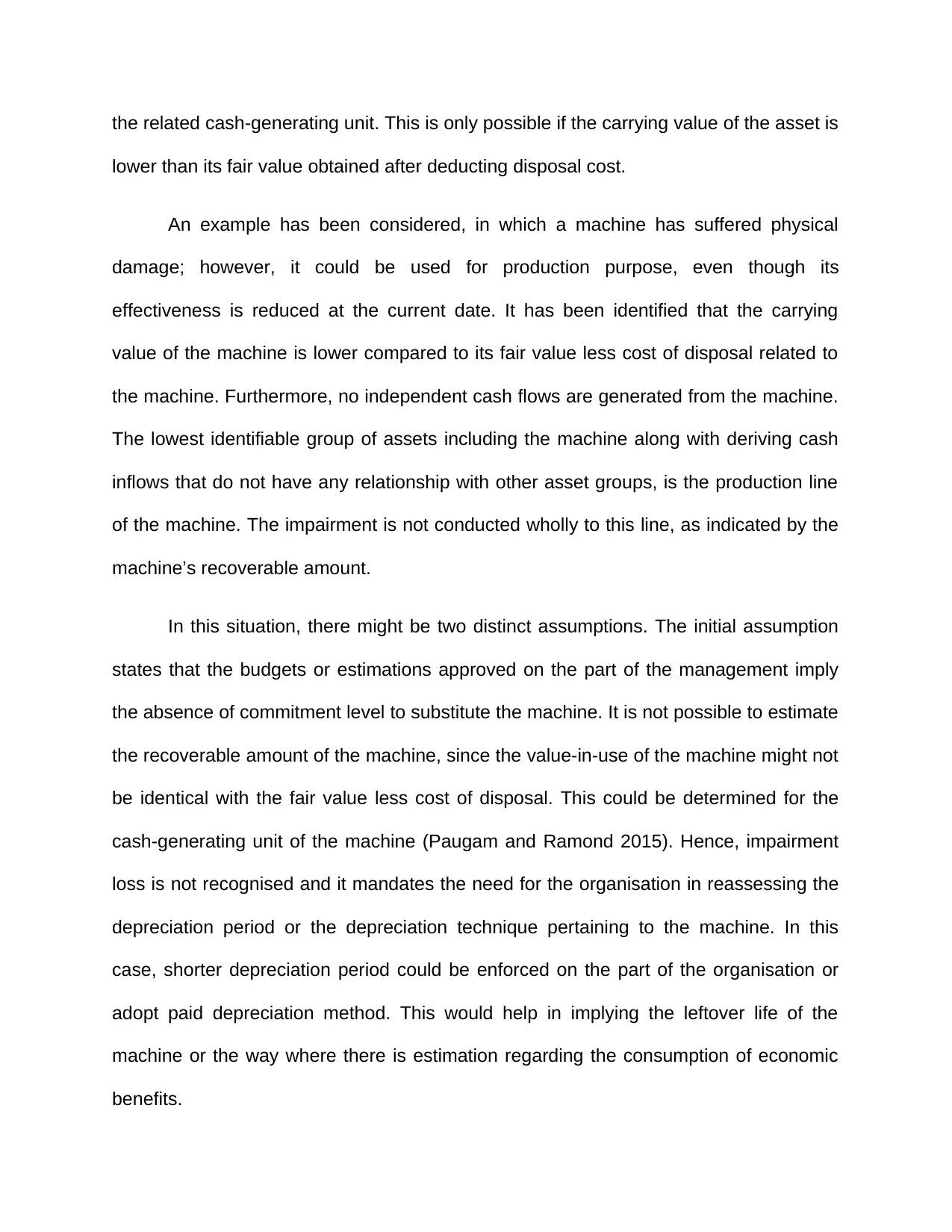
the related cash-generating unit. This is only possible if the carrying value of the asset is
lower than its fair value obtained after deducting disposal cost.
An example has been considered, in which a machine has suffered physical
damage; however, it could be used for production purpose, even though its
effectiveness is reduced at the current date. It has been identified that the carrying
value of the machine is lower compared to its fair value less cost of disposal related to
the machine. Furthermore, no independent cash flows are generated from the machine.
The lowest identifiable group of assets including the machine along with deriving cash
inflows that do not have any relationship with other asset groups, is the production line
of the machine. The impairment is not conducted wholly to this line, as indicated by the
machine’s recoverable amount.
In this situation, there might be two distinct assumptions. The initial assumption
states that the budgets or estimations approved on the part of the management imply
the absence of commitment level to substitute the machine. It is not possible to estimate
the recoverable amount of the machine, since the value-in-use of the machine might not
be identical with the fair value less cost of disposal. This could be determined for the
cash-generating unit of the machine (Paugam and Ramond 2015). Hence, impairment
loss is not recognised and it mandates the need for the organisation in reassessing the
depreciation period or the depreciation technique pertaining to the machine. In this
case, shorter depreciation period could be enforced on the part of the organisation or
adopt paid depreciation method. This would help in implying the leftover life of the
machine or the way where there is estimation regarding the consumption of economic
benefits.
lower than its fair value obtained after deducting disposal cost.
An example has been considered, in which a machine has suffered physical
damage; however, it could be used for production purpose, even though its
effectiveness is reduced at the current date. It has been identified that the carrying
value of the machine is lower compared to its fair value less cost of disposal related to
the machine. Furthermore, no independent cash flows are generated from the machine.
The lowest identifiable group of assets including the machine along with deriving cash
inflows that do not have any relationship with other asset groups, is the production line
of the machine. The impairment is not conducted wholly to this line, as indicated by the
machine’s recoverable amount.
In this situation, there might be two distinct assumptions. The initial assumption
states that the budgets or estimations approved on the part of the management imply
the absence of commitment level to substitute the machine. It is not possible to estimate
the recoverable amount of the machine, since the value-in-use of the machine might not
be identical with the fair value less cost of disposal. This could be determined for the
cash-generating unit of the machine (Paugam and Ramond 2015). Hence, impairment
loss is not recognised and it mandates the need for the organisation in reassessing the
depreciation period or the depreciation technique pertaining to the machine. In this
case, shorter depreciation period could be enforced on the part of the organisation or
adopt paid depreciation method. This would help in implying the leftover life of the
machine or the way where there is estimation regarding the consumption of economic
benefits.
Paraphrase This Document
Need a fresh take? Get an instant paraphrase of this document with our AI Paraphraser
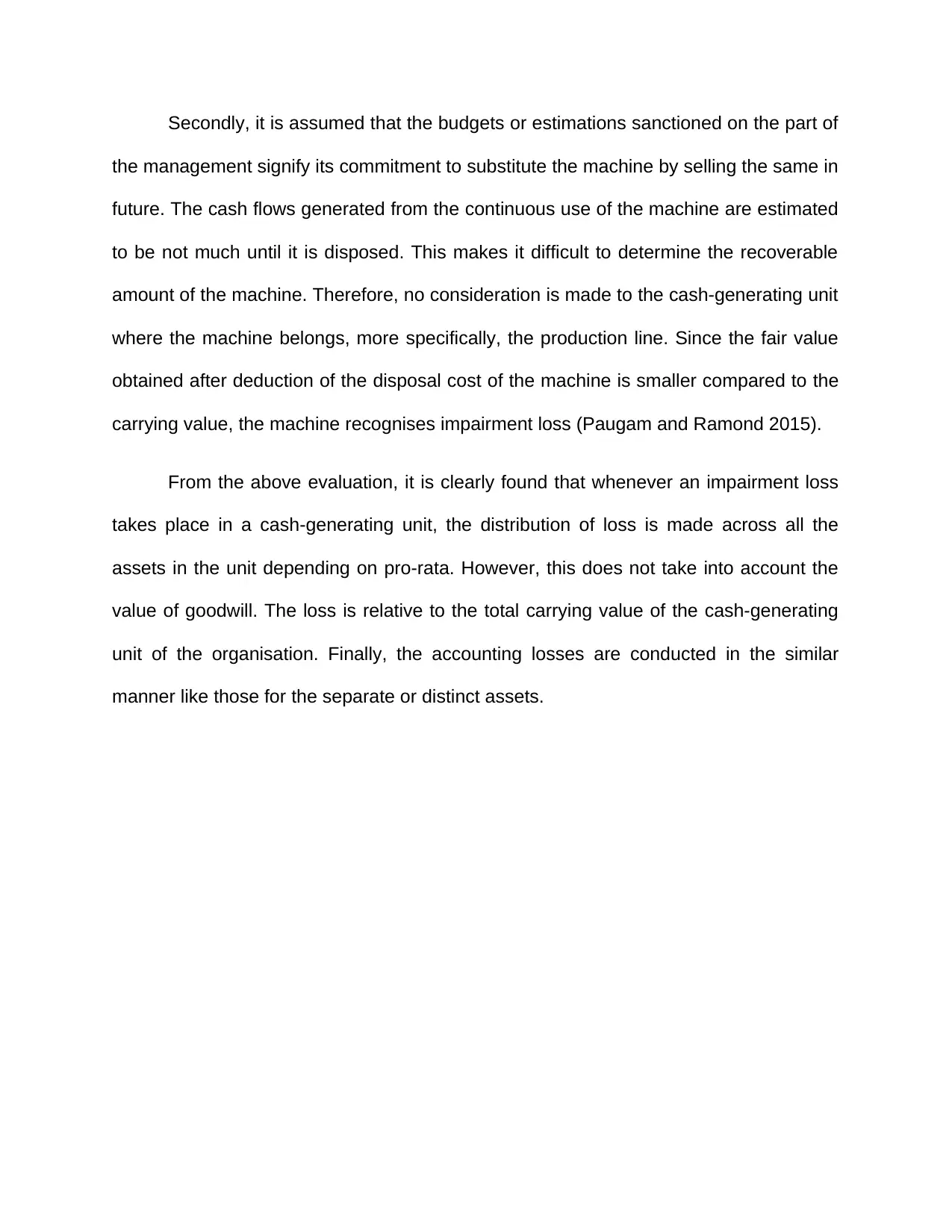
Secondly, it is assumed that the budgets or estimations sanctioned on the part of
the management signify its commitment to substitute the machine by selling the same in
future. The cash flows generated from the continuous use of the machine are estimated
to be not much until it is disposed. This makes it difficult to determine the recoverable
amount of the machine. Therefore, no consideration is made to the cash-generating unit
where the machine belongs, more specifically, the production line. Since the fair value
obtained after deduction of the disposal cost of the machine is smaller compared to the
carrying value, the machine recognises impairment loss (Paugam and Ramond 2015).
From the above evaluation, it is clearly found that whenever an impairment loss
takes place in a cash-generating unit, the distribution of loss is made across all the
assets in the unit depending on pro-rata. However, this does not take into account the
value of goodwill. The loss is relative to the total carrying value of the cash-generating
unit of the organisation. Finally, the accounting losses are conducted in the similar
manner like those for the separate or distinct assets.
the management signify its commitment to substitute the machine by selling the same in
future. The cash flows generated from the continuous use of the machine are estimated
to be not much until it is disposed. This makes it difficult to determine the recoverable
amount of the machine. Therefore, no consideration is made to the cash-generating unit
where the machine belongs, more specifically, the production line. Since the fair value
obtained after deduction of the disposal cost of the machine is smaller compared to the
carrying value, the machine recognises impairment loss (Paugam and Ramond 2015).
From the above evaluation, it is clearly found that whenever an impairment loss
takes place in a cash-generating unit, the distribution of loss is made across all the
assets in the unit depending on pro-rata. However, this does not take into account the
value of goodwill. The loss is relative to the total carrying value of the cash-generating
unit of the organisation. Finally, the accounting losses are conducted in the similar
manner like those for the separate or distinct assets.
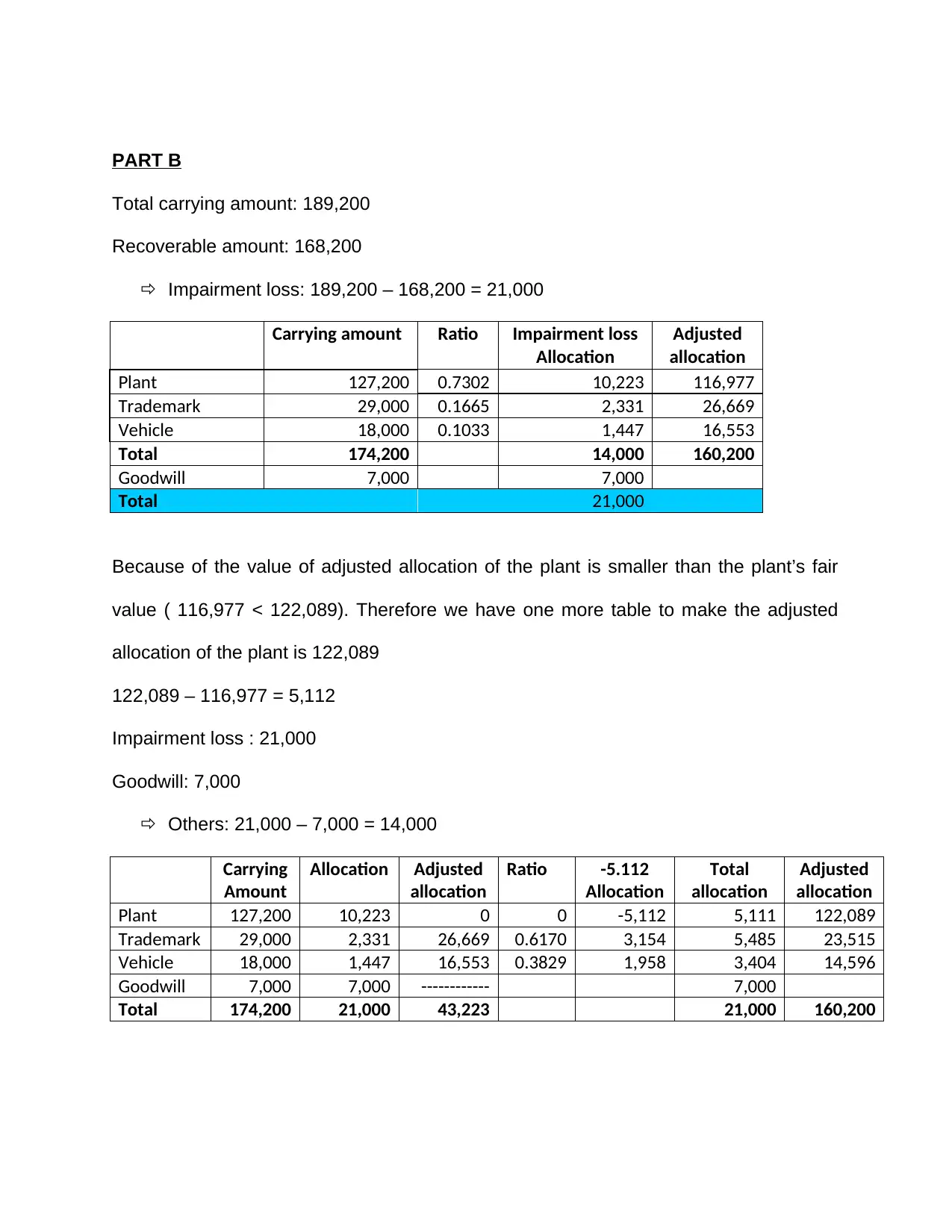
PART B
Total carrying amount: 189,200
Recoverable amount: 168,200
Impairment loss: 189,200 – 168,200 = 21,000
Carrying amount Ratio Impairment loss
Allocation
Adjusted
allocation
Plant 127,200 0.7302 10,223 116,977
Trademark 29,000 0.1665 2,331 26,669
Vehicle 18,000 0.1033 1,447 16,553
Total 174,200 14,000 160,200
Goodwill 7,000 7,000
Total 21,000
Because of the value of adjusted allocation of the plant is smaller than the plant’s fair
value ( 116,977 < 122,089). Therefore we have one more table to make the adjusted
allocation of the plant is 122,089
122,089 – 116,977 = 5,112
Impairment loss : 21,000
Goodwill: 7,000
Others: 21,000 – 7,000 = 14,000
Carrying
Amount
Allocation Adjusted
allocation
Ratio -5.112
Allocation
Total
allocation
Adjusted
allocation
Plant 127,200 10,223 0 0 -5,112 5,111 122,089
Trademark 29,000 2,331 26,669 0.6170 3,154 5,485 23,515
Vehicle 18,000 1,447 16,553 0.3829 1,958 3,404 14,596
Goodwill 7,000 7,000 ------------ 7,000
Total 174,200 21,000 43,223 21,000 160,200
Total carrying amount: 189,200
Recoverable amount: 168,200
Impairment loss: 189,200 – 168,200 = 21,000
Carrying amount Ratio Impairment loss
Allocation
Adjusted
allocation
Plant 127,200 0.7302 10,223 116,977
Trademark 29,000 0.1665 2,331 26,669
Vehicle 18,000 0.1033 1,447 16,553
Total 174,200 14,000 160,200
Goodwill 7,000 7,000
Total 21,000
Because of the value of adjusted allocation of the plant is smaller than the plant’s fair
value ( 116,977 < 122,089). Therefore we have one more table to make the adjusted
allocation of the plant is 122,089
122,089 – 116,977 = 5,112
Impairment loss : 21,000
Goodwill: 7,000
Others: 21,000 – 7,000 = 14,000
Carrying
Amount
Allocation Adjusted
allocation
Ratio -5.112
Allocation
Total
allocation
Adjusted
allocation
Plant 127,200 10,223 0 0 -5,112 5,111 122,089
Trademark 29,000 2,331 26,669 0.6170 3,154 5,485 23,515
Vehicle 18,000 1,447 16,553 0.3829 1,958 3,404 14,596
Goodwill 7,000 7,000 ------------ 7,000
Total 174,200 21,000 43,223 21,000 160,200
⊘ This is a preview!⊘
Do you want full access?
Subscribe today to unlock all pages.

Trusted by 1+ million students worldwide
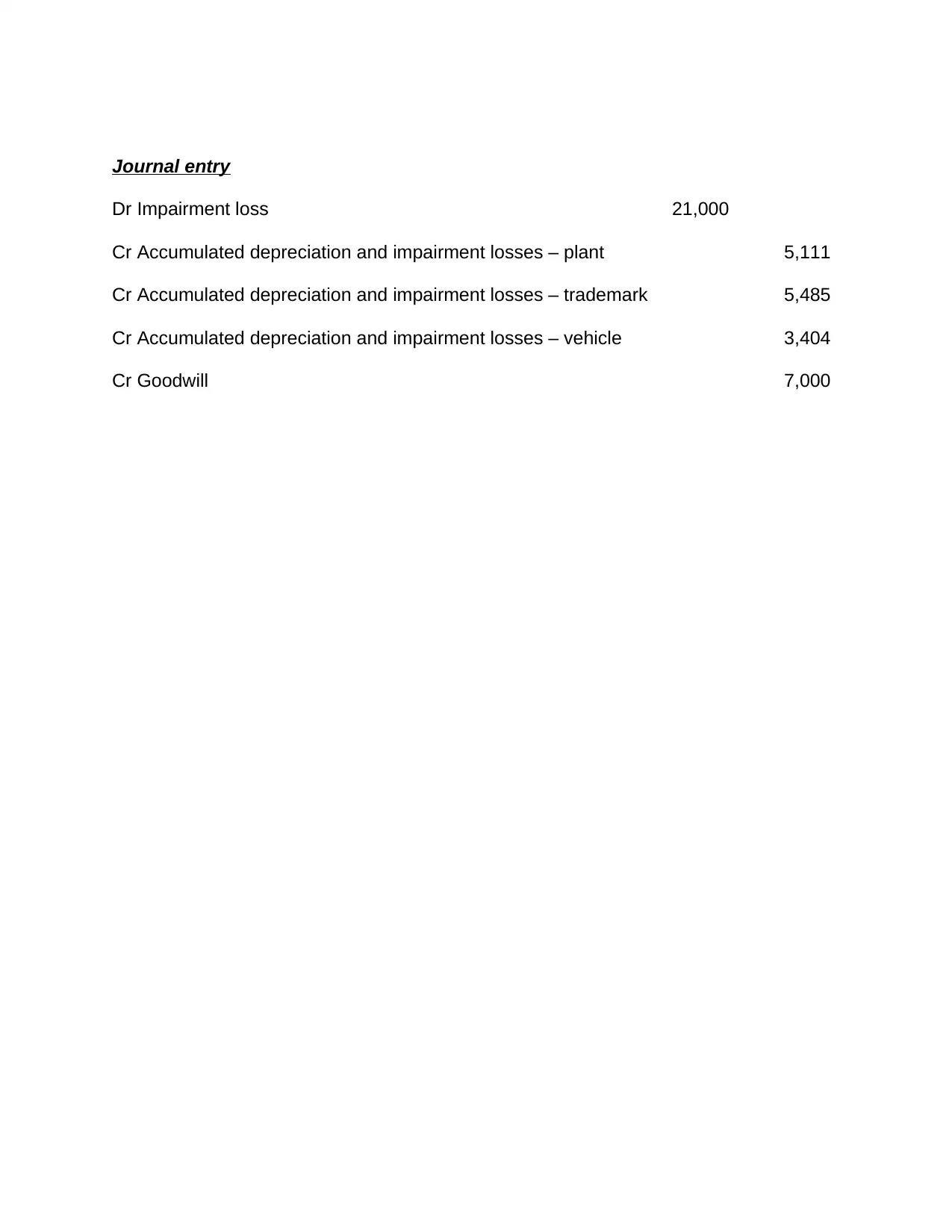
Journal entry
Dr Impairment loss 21,000
Cr Accumulated depreciation and impairment losses – plant 5,111
Cr Accumulated depreciation and impairment losses – trademark 5,485
Cr Accumulated depreciation and impairment losses – vehicle 3,404
Cr Goodwill 7,000
Dr Impairment loss 21,000
Cr Accumulated depreciation and impairment losses – plant 5,111
Cr Accumulated depreciation and impairment losses – trademark 5,485
Cr Accumulated depreciation and impairment losses – vehicle 3,404
Cr Goodwill 7,000
Paraphrase This Document
Need a fresh take? Get an instant paraphrase of this document with our AI Paraphraser
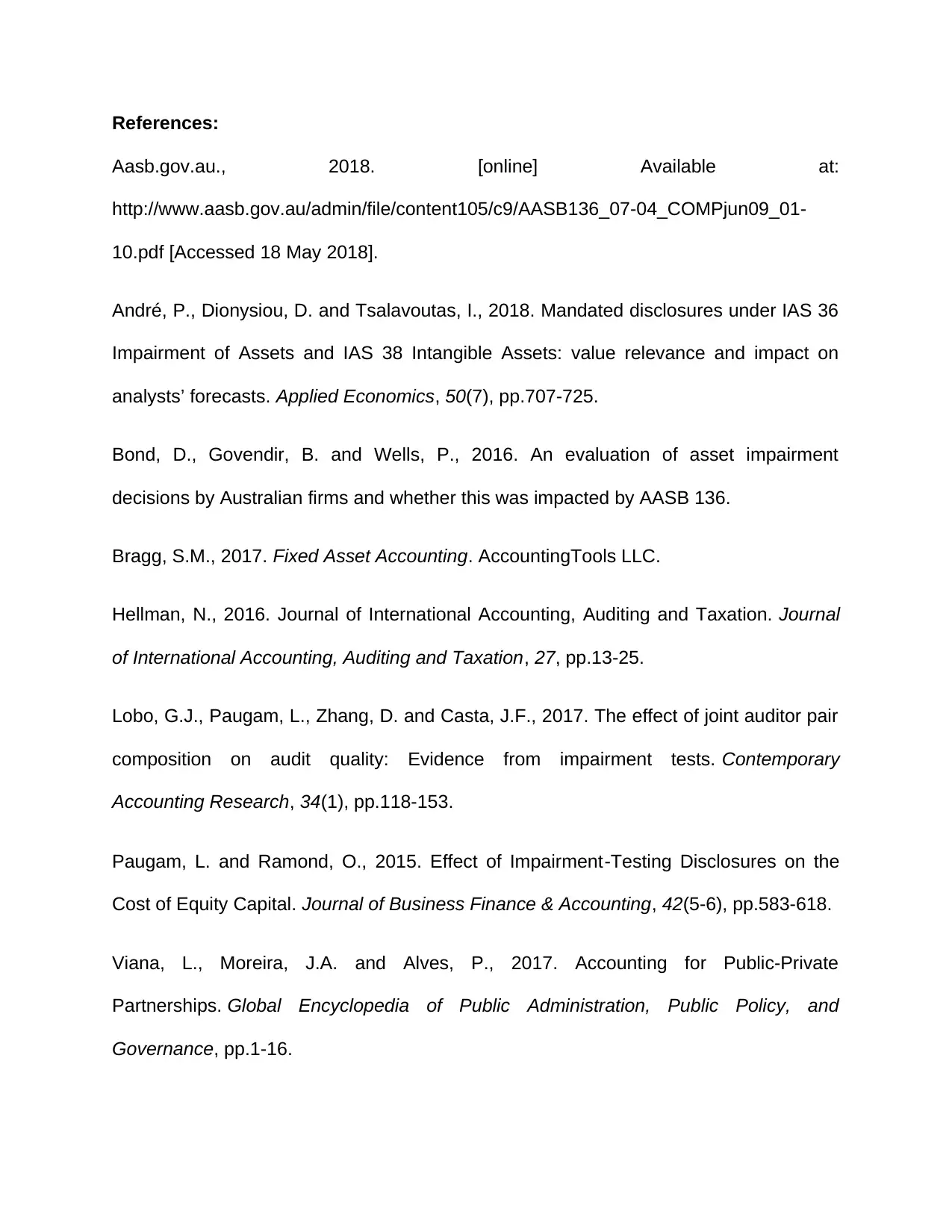
References:
Aasb.gov.au., 2018. [online] Available at:
http://www.aasb.gov.au/admin/file/content105/c9/AASB136_07-04_COMPjun09_01-
10.pdf [Accessed 18 May 2018].
André, P., Dionysiou, D. and Tsalavoutas, I., 2018. Mandated disclosures under IAS 36
Impairment of Assets and IAS 38 Intangible Assets: value relevance and impact on
analysts’ forecasts. Applied Economics, 50(7), pp.707-725.
Bond, D., Govendir, B. and Wells, P., 2016. An evaluation of asset impairment
decisions by Australian firms and whether this was impacted by AASB 136.
Bragg, S.M., 2017. Fixed Asset Accounting. AccountingTools LLC.
Hellman, N., 2016. Journal of International Accounting, Auditing and Taxation. Journal
of International Accounting, Auditing and Taxation, 27, pp.13-25.
Lobo, G.J., Paugam, L., Zhang, D. and Casta, J.F., 2017. The effect of joint auditor pair
composition on audit quality: Evidence from impairment tests. Contemporary
Accounting Research, 34(1), pp.118-153.
Paugam, L. and Ramond, O., 2015. Effect of Impairment‐Testing Disclosures on the
Cost of Equity Capital. Journal of Business Finance & Accounting, 42(5-6), pp.583-618.
Viana, L., Moreira, J.A. and Alves, P., 2017. Accounting for Public-Private
Partnerships. Global Encyclopedia of Public Administration, Public Policy, and
Governance, pp.1-16.
Aasb.gov.au., 2018. [online] Available at:
http://www.aasb.gov.au/admin/file/content105/c9/AASB136_07-04_COMPjun09_01-
10.pdf [Accessed 18 May 2018].
André, P., Dionysiou, D. and Tsalavoutas, I., 2018. Mandated disclosures under IAS 36
Impairment of Assets and IAS 38 Intangible Assets: value relevance and impact on
analysts’ forecasts. Applied Economics, 50(7), pp.707-725.
Bond, D., Govendir, B. and Wells, P., 2016. An evaluation of asset impairment
decisions by Australian firms and whether this was impacted by AASB 136.
Bragg, S.M., 2017. Fixed Asset Accounting. AccountingTools LLC.
Hellman, N., 2016. Journal of International Accounting, Auditing and Taxation. Journal
of International Accounting, Auditing and Taxation, 27, pp.13-25.
Lobo, G.J., Paugam, L., Zhang, D. and Casta, J.F., 2017. The effect of joint auditor pair
composition on audit quality: Evidence from impairment tests. Contemporary
Accounting Research, 34(1), pp.118-153.
Paugam, L. and Ramond, O., 2015. Effect of Impairment‐Testing Disclosures on the
Cost of Equity Capital. Journal of Business Finance & Accounting, 42(5-6), pp.583-618.
Viana, L., Moreira, J.A. and Alves, P., 2017. Accounting for Public-Private
Partnerships. Global Encyclopedia of Public Administration, Public Policy, and
Governance, pp.1-16.
1 out of 8
Related Documents
Your All-in-One AI-Powered Toolkit for Academic Success.
+13062052269
info@desklib.com
Available 24*7 on WhatsApp / Email
![[object Object]](/_next/static/media/star-bottom.7253800d.svg)
Unlock your academic potential
Copyright © 2020–2025 A2Z Services. All Rights Reserved. Developed and managed by ZUCOL.


